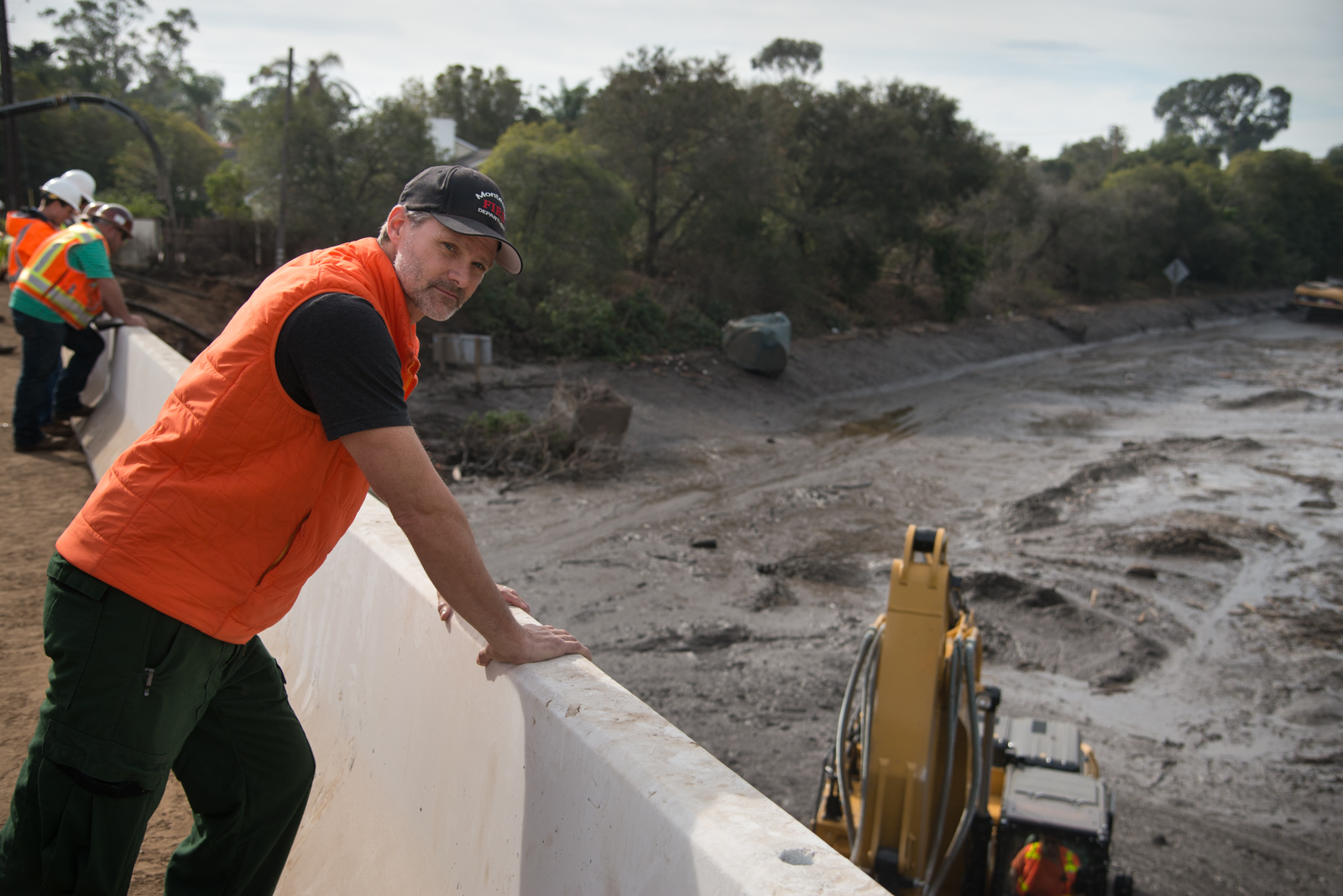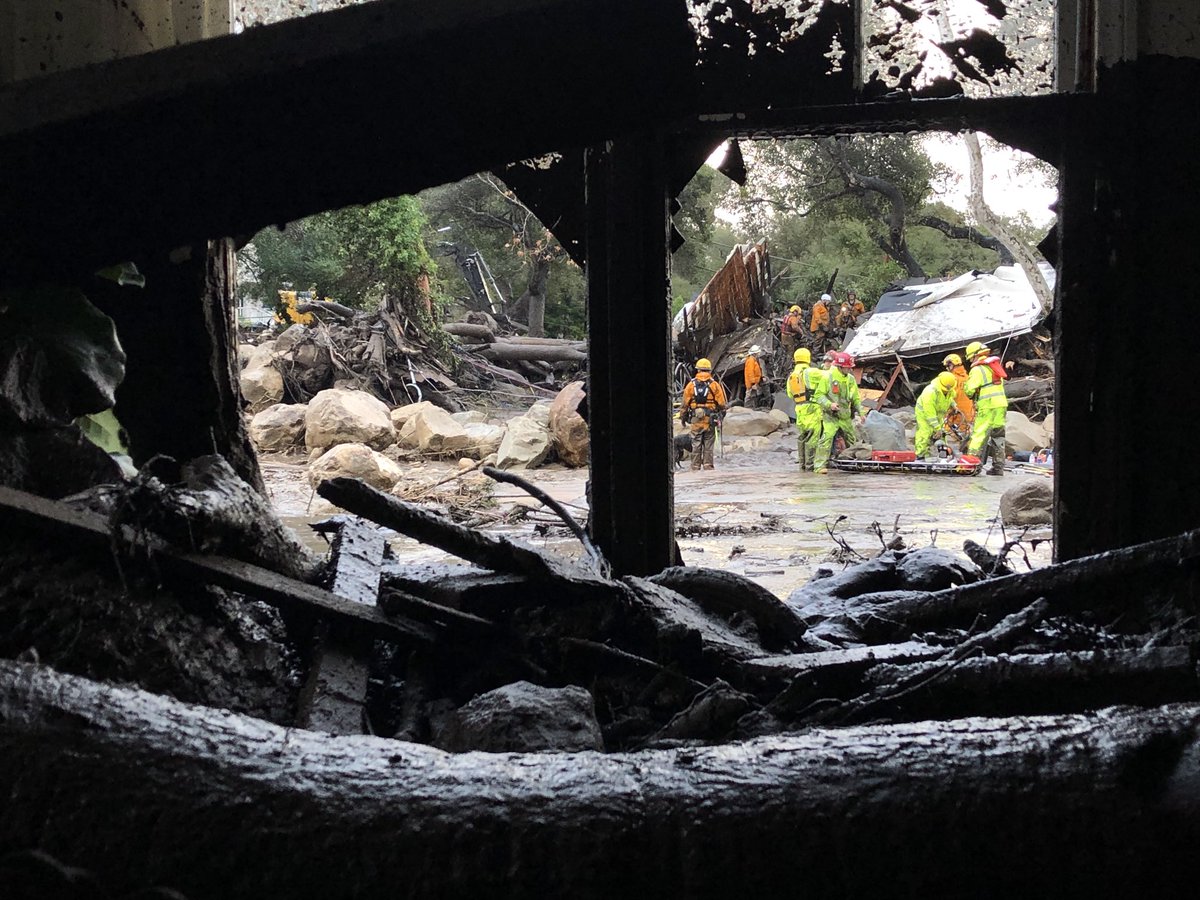Straight Talk on Montecito Evacuation Reaction and the Flood
Montecito Fire District's Abe Powell Reveals Officials' Anxiety Before Storm and Fearless Response to Mudflow

On the evening of Monday, January 8, Abe Powell and his family left their creek-side home in Montecito for the safety of a private residence on West Mountain Drive, away from steep mountainsides scorched bare by the Thomas Fire. A few hours later, Powell remembered, the pounding rain unleashed rockfalls that echoed violently like the clash of colliding billiard balls. Then, in a nearby canyon, a torrent of debris snapped a 22-inch high-pressure natural gas line. “All of a sudden,” he said, “there’s a plume of fire shooting up into the sky. You could see these pulsing flames from Gibraltar Road to Carpinteria. I thought, ‘Oh, lord, we’re really in for it.’”
For the past five years, Powell has served on the elected Board of Directors of the Montecito Fire Protection District. He takes public safety very seriously, and when firestorms and rainstorms bear down, friends, family, and followers turn to him for reliable information and prudent advice. In that respect, he’s been voluntarily on the clock since early December, when the lit fuse of the Thomas Fire culminated in the deadly mudflows that would change Montecito forever.
Earlier this week, the Santa Barbara Independent caught up with Powell to reflect on the disaster.
When did you first become alarmed? After the Thomas Fire, Montecito’s Chief Chip Hickman and Kevin Taylor snapped into gear, looking at the flood maps and talking to the U.S. Forest Service BAER [Burn Area Emergency Response] team. The BAER team said to take the 500-year flood map and multiply it by 10 — that’s what we’re expecting with more than a half inch of rain an hour. So we’re looking at that, with no holding capacity in the watershed [because it’s been burned away]. Basically, BAER was saying, You guys are in grave danger if it rains hard. This was a week before the storm. Hickman and Taylor, these guys don’t get ruffled by anything, and Taylor was a little bit agitated trying to get me to understand how serious he thought it was. His agitation is what snapped me into action.
Did they ask anything of you? They told me to message people about how serious this was. I asked if there would be evacuations, and at that point they didn’t know, but it was likely. I went from being theoretically concerned to materially worried. That’s when I started calling people and posting on Facebook that I thought this was serious.
What did you tell people? I spent three days at the sandbag facility at Lower Manning Park. I was telling people to put in their sandbags, and then pack up and go. I told them, “I’m in the voluntary evacuation zone, and I’m taking my family and leaving.” The response I got was either mild confusion or disbelief. People just didn’t think it could be that bad. Even part of me didn’t think it could be that bad.
How many people did you tell to leave? Hundreds. Literally, it was eight hours a day in front of a sand pile with cars coming in and out all day. I stayed until about 6:30 Monday night. We took a last delivery of sand, and I convinced some friends to leave. My wife and kids are waiting for me, and it’s raining, and that’s when I set the example I said I would — to leave.
Were you surprised so many people decided to stay? No. Because I was exhausted from evacuation fatigue. We’d been out of our house for weeks because of the fire. We were tired of living out of suitcases.
Some people you talked to probably stayed and didn’t make it. That’s a really sensitive issue. Did I talk to people who are now not with us? Yes, I did. How do I feel about that? Mostly really sad. Could I have communicated to them better? I’m trying not to be mad at myself because I know I was doing my best.
Do you think the warnings from Santa Barbara County officials were stern enough? Here’s what I think. They’d never done an evacuation like that for a flood. They thought that their warnings were like cannon shots across everybody’s bow. A mandatory evacuation for a flood in Santa Barbara — that’s never happened. Everybody was perplexed by the mild reaction. We didn’t even get 20 percent evacuation in the mandatory zone. I think they thought that they had messaged it pretty clearly, and they issued the evacuation. In hindsight, I’m sure they wish the whole of Montecito had been mandatory. But I think it’s really just hard to imagine that level of devastation. It’s an unprecedented, off-the-chart flood.
In terms of how that evacuation went down, we all learned a lot of lessons, and I think we all would have been much more strident. One of the baseline things in an evacuation is that they’re trying not to cause a panic. There’s that balance of don’t cause panic but communicate your anxiety, and they always try to do it in a very calm fashion.
What would have gotten more people to leave? They sent notices, they sent the evacuation warnings, and then a person comes to your door and says, “Please leave.” I don’t think there was much more they could have done. Public agencies are responsible for doing all the things they did, but ultimately everybody is responsible for their own safety. At some point the burden is on us to help ourselves be safe, to keep our families safe and protect our kids.
But your own home, right next to a creek, was in a voluntary evacuation zone. Didn’t that seem odd to you? No. To even be in a voluntary zone seemed significant to me. The problem with evacuating for a flood is that our evacuation zones aren’t broken up by watersheds. They’re broken up by roads. If you look at our zone map, it’s broken up in boxes, and you evacuate people from that box. Part of that is so you can protect it from looting. Once you clear everybody out, you kind of own it, and now you have to keep it safe.
Trying to evacuate just the watersheds? They don’t know how to do that yet. So what they did, they gave people that map showing the flood zones. They said if you’re in the flood zones, you should leave now. They posted that map on Friday, and they said, find your place; if you’re in the blue area, it’s time to go. Then on Sunday they posted the evacuation orders, and the overlay on the map of the red and yellow evacuation areas covered up the flood zones. You couldn’t see the flood map anymore underneath it.

It wasn’t a watershed-based warning anymore. The map lost that ability, especially in the voluntary area. If you look at the first map, that’s where the flooding was. It was actually worse than that.
People inside the disaster area wanted to search and dig for survivors. What’s wrong with that? There are so many hazards. Places where electricity is still on in the mud. Household hazardous chemicals. There are gas mains broken. Swimming pools you can’t see [because they’re covered in mud]. The first responders are watching each other’s backs, and they have a system to assess threats and adjust their tactics. What they were doing was a very technical rescue. And when you have uninitiated humans entering that scenario, they’re just in the way, and they could get hurt and need to be rescued. It was so dangerous and so unstable, and the mountain could still come down, even after it stops raining.
What about people driving their own heavy equipment for cleanup? Really bad idea. They wanted to clear their property but could’ve literally killed somebody still alive under the mud.
Why was establishment of the Public Safety Evacuation Zone on January 11 a necessary step? What I saw in Montecito that day were people riding bikes, driving around on roads that were primary conduits for emergency vehicles, and getting out of their cars to take selfies. It was an absolute shitshow. There were people wanting to get in and out, getting in the way of people trying to save lives. They were bogging down the sheriff. Deputies had their heads in these cars, talking to people wanting special treatment instead of having their heads up on a swivel to protect us from looters.
And when Montecito Sanitary District came back online, they weren’t certain where the poop was going. All of a sudden, all these people sheltering in place are flushing the toilet into what? Into the rescue operation? That’s a huge problem.
That was a really critical time because we were getting late into the rescue operation. These were our last hours when we thought we’d have a chance to pull somebody out alive. The sheriff was mad. Firefighters were mad. So they dropped the hammer.
[Update, 6:00 p.m.: Powell would like to clarify that “the hammer” — the Public Safety Evacuation Zone — was dropped on account of people getting in the way of critical rescue operations, and not in any way, shape, or form upon Montecito Sanitary District.]
Any problems with drones? There were people flying drones the first morning, and I went berserk. Drones make it so the helicopters can’t go in there to rescue people. People just need to understand that your need to take a picture is not more significant than somebody else’s need to be saved.
What jumps out as something we should all be proud of? The search and rescue. Just straight-up badass. Those guys got in there, just fearless. They knew the mountain could come down and kill them, and they ran in there in waist-deep in mud. Those guys who rescued Lauren Cantin — Andy Rupp and the other Montecito Fire guys, they had been training their swift-water rescue techniques in Lower Manning while we were sandbagging. They were getting ready and the storm hit, and they turned around and saved people.
Anything you’d like to add? From a public-safety perspective, there are a lot of lessons we’re going to learn from this. But really the story right now is the saves. The people that got saved, and those who trained their whole lives for that moment to go in and get those men and women and kids and pets. That’s the whole reason those guys signed up for any of this. They went out and executed it in the most extreme circumstances we’ve ever seen. We’ve just been through the most extreme fire ever in California and then the worst flood we’ve ever seen just hit us, and they went out and pulled people out of that mud. It’s just incredible.



